讲学稿--unit 8 period 6
- 格式:doc
- 大小:32.50 KB
- 文档页数:2

八年级英语下册unit8说课稿八年级英语下册unit8说课稿Presentatin f teahing fr G Fr It!Ss BkB Grade 8Gd rning, y dear udges and teahers.It’s y great hnr t present y lessn here. Tday, I’ging t talk abut unit 8 Have yu read Treasure Island yet? , whih is taken fr G Fr It! Ss BkB Grade 8. y presentatin nsists f the fllwing 4 parts: the analysis f teahing aterial; teahing ethds; studying ethds and teahing preduresNw, I’ll begin with the first part. It’s the first perid f this unit and it’s a listening and speaking lass. It plays a very iprtant rle in develping Ss’integrate language-using skills. The tpi is talking abut reent events and experienes .It’s lse t Ss’ daily life. S I believe it’s easy t raise their interest f learning English. Based n a full understanding funir shl English urriulu and teahing aterial, I ade the fllwing teahing ais.Fr the knwledge ais, they need t learn the key wrdsand phrases by using the target language Have yu read…yet?. The ability ai is t iprve their listening, speaking and uniative abilities. And the etinal ai is t ake the knw that bks are the ladder f huan prgress. And enurage the t read re bks n literature and eny reading.In this perid, I hse vabulary, sentene struture and listening as the teahing key pints. yu knw Re isn’t built in ne day. It’s neessary fr the English beginners t aster se basi language skills. Arding t the priniples f new nept f urriulu“Learning by ding, learning by using”, it’s ur task t fus n students and ake the the real asters in lass while the teaher hiself ats as a diretr and a guider. S I designed lts f ral pratie t break thrugh the diffiult pints.Then, let’s e t the analysis f teahing ethds. yu knw New urriulu standard require us t develping Ss’integrate abilities suh as listening, speaking, reading and writing. In rder t ahieve these three diensinal teahing ais, I ainly use the fllwing teahing ethds: task-based teahing apprah, brainstr, guessing gaes, listening and speaking, pair wrk, rle-play, interview and s n. I believe different kinds f teahingethds will ake y lass vivid and alive. f urse, it’s neessary fr Ss t aster the rret studying ethds. Ss are requested t study English reatively and independently. S I think listening and speaking, peratin in grups are the ain studying ethds fr the, whih will ake the tasks and ativities uh easier and whih an als ake the re nfident and ative in lass. The teahing aids I will ainly use are the text bk and se ards.Next let’s e t the teahing predures. It nsists f 6 parts.1. aring-up and lead-in (free talk t ake the relaxed befre lass, f urse it’s a best way t shrten the distane between us sine we’re unfailiar with eah ther. Then have a quik lead-in t raise their urisity and interest in learning English. )2. Free talk (It’s a language input. The purpse is t present the key wrds, phrases by using the target language)3. Pair wrk( t pratie the target language and iprve their listening ability and ral English )4. Grup-wrk (It’s a liax. Language utput, t reatea real situatin fr Ss t ake a survey then give a reprtin lass)5. Suary and hewrk(T have a brief suary and ephasis the etinal ai)6. Blakbard designUnit8 Have yu read Treasure Island yet?Setin A(1a~2)--Have yu read Little enyet?--yes, I have. I have already read it.--N, I haven’t. I haven’t read it yet.--hat’s it like?–It’s fantasti/wnderful/exiting/great/interesting/ bring/terrible/uninteresting.Strutures: have/has + Past Partiiple。
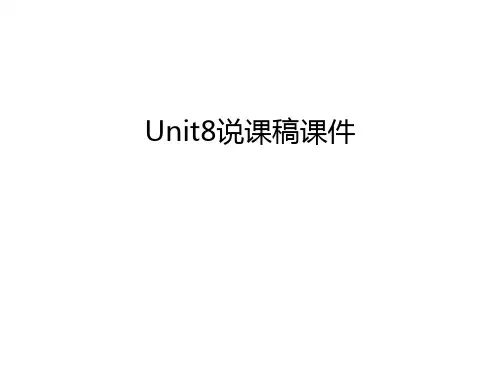
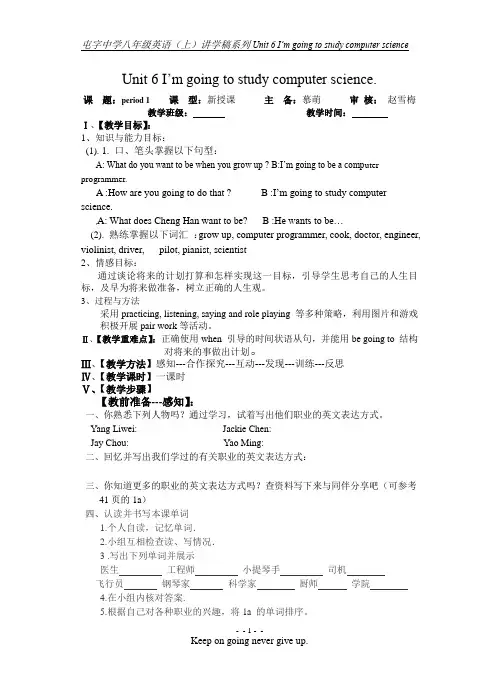
Unit 6 I’m going to study computer science.课题:period 1课型:新授课主备:慕萌审核:赵雪梅教学班级:教学时间:Ⅰ、【教学目标】:1、知识与能力目标:(1). 1. 口、笔头掌握以下句型:A: What do you want to be when you grow up ? B:I’m going to be a comp uter programmer.A :How are you going to do that ?B :I’m going to study computer science.A: What does Cheng Han want to be? B :He wants to be…(2).熟练掌握以下词汇:grow up, computer programmer, cook, doctor, engineer, violinist, driver, pilot, pianist, scientist2、情感目标:通过谈论将来的计划打算和怎样实现这一目标,引导学生思考自己的人生目标,及早为将来做准备,树立正确的人生观。
3、过程与方法采用practicing, listening, saying and role playing 等多种策略,利用图片和游戏积极开展pair work等活动。
Ⅱ、【教学重难点】:正确使用when 引导的时间状语从句,并能用be going to 结构对将来的事做出计划。
Ⅲ、【教学方法】感知---合作探究---互动---发现---训练---反思Ⅳ、【教学课时】一课时Ⅴ、【教学步骤】【教前准备---感知】:一、你熟悉下列人物吗?通过学习,试着写出他们职业的英文表达方式。
Yang Liwei:_____________ Jackie Chen:______________Jay Chou: _____________ Yao Ming: ______________二、回忆并写出我们学过的有关职业的英文表达方式:___________________________________三、你知道更多的职业的英文表达方式吗?查资料写下来与同伴分享吧(可参考41页的1a)四、认读并书写本课单词1.个人自读,记忆单词.2.小组互相检查读、写情况.3 .写出下列单词并展示医生工程师小提琴手司机飞行员钢琴家科学家厨师学院4.在小组内核对答案.5.根据自己对各种职业的兴趣,将1a 的单词排序。
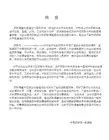
八年级英语下册Unit 8知识讲解Unit8hdn’tugetherasarf?【单元目标】Ⅰ.单词与短语suggestin hse enter advantage reeivebesides ent enurage present trendspeial albu persnal instead useperfet pan asleep prgress benhSeden native nearlfallasleep 入睡giveaa 赠送ratherthan 胜于hearf 听说suggest v提议;建议taeaninterestin 对……感兴趣aefriendsith 与……交友Ⅱ.目标句型:1hatshuldIgetfrsb…? 2Habutsth/dingsth?3Hduliesth?4hatabutsth/dingsth?hdn’tubu/get…? 6hntbu/get…?7The’retexpensive/heap/persnal…8Great!/Gdidea!/…I’llget/bu…9bestgiftis…10It’sgdfrsbt…11Itanaesb…Ⅲ.重点句型1hdn’tsbdsth? 2Habut结构3t…t结构【重点词汇】1iprve作不及物动词,表示“改进,改善”例如:Hisrisiprvingsll 他的工作提高得很慢。
Hishealthisiprving 他的健康正在好转。
也可作及物动词,表示“使某物改进,改善”。
例如:HestudieshardertiprvehisEnglish 他更加努力提高英语水平了。
ThisisntgdenughIanttiprveit 这还不够好,我要加以改进。
2reeber v记住,记起Ian’treeberurnae 我记不起你的名字。
AsfarasIanreeber,thisisthethirdtiee’veet我记得这是我们第三次会面了。
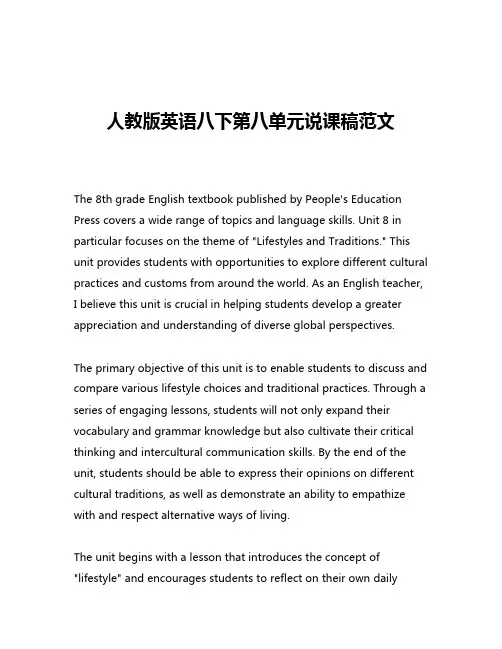
人教版英语八下第八单元说课稿范文The 8th grade English textbook published by People's Education Press covers a wide range of topics and language skills. Unit 8 in particular focuses on the theme of "Lifestyles and Traditions." This unit provides students with opportunities to explore different cultural practices and customs from around the world. As an English teacher, I believe this unit is crucial in helping students develop a greater appreciation and understanding of diverse global perspectives.The primary objective of this unit is to enable students to discuss and compare various lifestyle choices and traditional practices. Through a series of engaging lessons, students will not only expand their vocabulary and grammar knowledge but also cultivate their critical thinking and intercultural communication skills. By the end of the unit, students should be able to express their opinions on different cultural traditions, as well as demonstrate an ability to empathize with and respect alternative ways of living.The unit begins with a lesson that introduces the concept of "lifestyle" and encourages students to reflect on their own dailyroutines and habits. Students will be asked to share their typical daily activities, such as waking up, getting ready for school, having meals, and spending leisure time. This initial activity serves as a foundation for later comparisons with lifestyles in other cultures.The next few lessons focus on specific cultural traditions and practices. For example, one lesson might explore the traditional clothing and fashion styles of different regions, while another delves into various coming-of-age ceremonies and rituals. Students will have the opportunity to learn about the historical significance, symbolic meanings, and social functions of these cultural elements. Through reading comprehension exercises, discussions, and multimedia presentations, students will develop a deeper understanding of the diversity of human experiences and the rich tapestry of global traditions.To further engage students and promote cross-cultural exchange, the unit includes a project-based learning activity. Students will be divided into small groups and assigned to research a particular cultural tradition or lifestyle practice. They will be tasked with gathering information, analyzing the cultural context, and preparing a multimedia presentation to share their findings with the class. This collaborative project not only strengthens students' research and presentation skills but also encourages them to approach cultural differences with an open and curious mindset.Another key aspect of this unit is the inclusion of language skills development. Throughout the lessons, students will be exposed to a variety of text types, such as informative articles, personal narratives, and persuasive essays. They will practice reading comprehension strategies, analyze the structure and language features of these texts, and engage in guided writing exercises to improve their own academic and creative writing abilities.Additionally, the unit incorporates opportunities for oral communication practice. Students will participate in discussions, debates, and role-play activities to enhance their fluency, pronunciation, and pragmatic competence. These interactive tasks will encourage students to express their opinions, ask questions, and engage in respectful dialogue with their peers.To assess student learning, the unit will include a range of formative and summative assessments. Formative assessments, such as quizzes, short writing tasks, and classroom observations, will provide ongoing feedback to both teachers and students, allowing for timely adjustments and support. The summative assessment, which may take the form of a comprehensive project or a written exam, will evaluate students' overall understanding of the unit's content and their ability to apply the language skills they have acquired.Throughout the implementation of this unit, it is crucial for the teacher to foster an inclusive and culturally responsive classroom environment. This involves acknowledging and validating the diverse backgrounds and experiences of the students, as well as actively challenging stereotypes and promoting cultural sensitivity. By creating a safe and respectful learning space, the teacher can encourage students to share their own cultural perspectives, ask thoughtful questions, and engage in meaningful discussions.Furthermore, the teacher should incorporate a variety of instructional strategies and learning resources to cater to the diverse learning needs and preferences of the students. This may include the use of visual aids, audio-visual materials, collaborative activities, and differentiated assignments. By adopting a flexible and student-centered approach, the teacher can ensure that all learners are able to actively participate and derive valuable insights from the unit's content.In conclusion, the 8th grade English textbook's Unit 8 on "Lifestyles and Traditions" presents an excellent opportunity for students to develop a deeper understanding and appreciation of cultural diversity. Through a well-designed curriculum that combines language skill development with intercultural exploration, students will not only improve their English proficiency but also cultivate essential 21st-century skills, such as critical thinking, communication,and global awareness. By implementing this unit effectively, teachers can empower their students to become informed, empathetic, and responsible global citizens, ready to navigate the complexities of our interconnected world.。
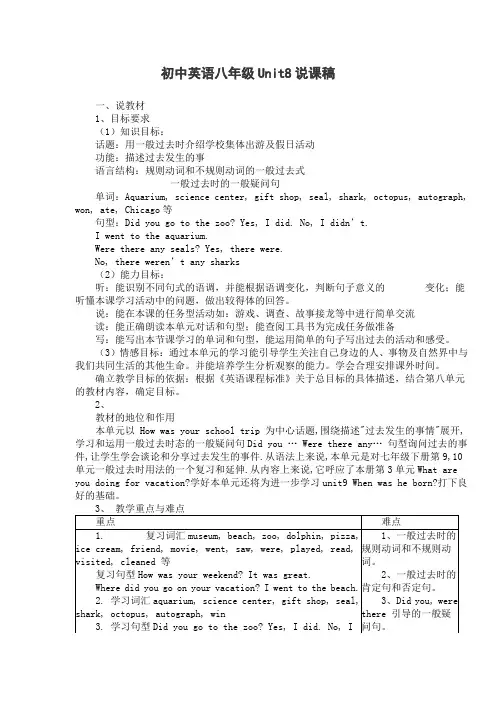
初中英语八年级Unit8说课稿一、说教材1、目标要求(1)知识目标:话题:用一般过去时介绍学校集体出游及假日活动功能:描述过去发生的事语言结构:规则动词和不规则动词的一般过去式一般过去时的一般疑问句单词:Aquarium, science center, gift shop, seal, shark, octopus, autograph, won, ate, Chicago等句型:Did you go to the zoo? Yes, I did. No, I di dn’t.I went to the aquarium.Were there any seals? Yes, there were.No, there weren’t any sharks(2)能力目标:听:能识别不同句式的语调,并能根据语调变化,判断句子意义的变化;能听懂本课学习活动中的问题,做出较得体的回答。
说:能在本课的任务型活动如:游戏、调查、故事接龙等中进行简单交流读:能正确朗读本单元对话和句型;能查阅工具书为完成任务做准备写:能写出本节课学习的单词和句型,能运用简单的句子写出过去的活动和感受。
(3)情感目标:通过本单元的学习能引导学生关注自己身边的人、事物及自然界中与我们共同生活的其他生命。
并能培养学生分析观察的能力。
学会合理安排课外时间。
确立教学目标的依据:根据《英语课程标准》关于总目标的具体描述,结合第八单元的教材内容,确定目标。
2、教材的地位和作用本单元以 How was your school trip 为中心话题,围绕描述"过去发生的事情"展开,学习和运用一般过去时态的一般疑问句Did you … Were there any… 句型询问过去的事件,让学生学会谈论和分享过去发生的事件.从语法上来说,本单元是对七年级下册第9,10单元一般过去时用法的一个复习和延伸.从内容上来说,它呼应了本册第3单元What are you doing for vacation?学好本单元还将为进一步学习unit9 When was he born?打下良好的基础。
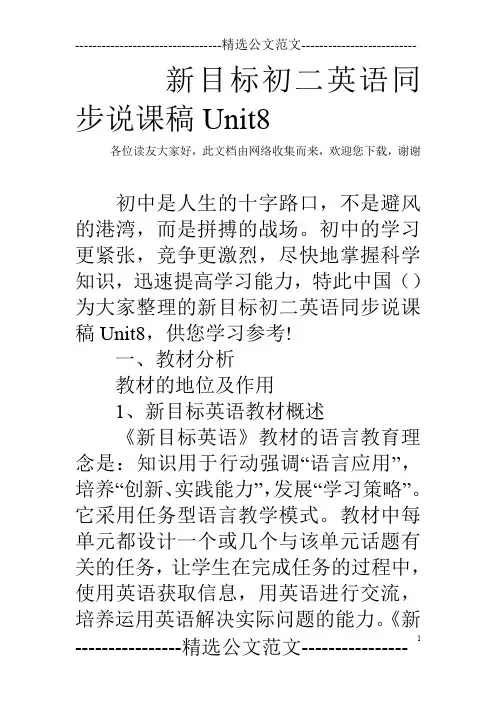
新目标初二英语同步说课稿Unit8各位读友大家好,此文档由网络收集而来,欢迎您下载,谢谢初中是人生的十字路口,不是避风的港湾,而是拼搏的战场。
初中的学习更紧张,竞争更激烈,尽快地掌握科学知识,迅速提高学习能力,特此中国()为大家整理的新目标初二英语同步说课稿Unit8,供您学习参考!一、教材分析教材的地位及作用1、新目标英语教材概述《新目标英语》教材的语言教育理念是:知识用于行动强调“语言应用”,培养“创新、实践能力”,发展“学习策略”。
它采用任务型语言教学模式。
教材中每单元都设计一个或几个与该单元话题有关的任务,让学生在完成任务的过程中,使用英语获取信息,用英语进行交流,培养运用英语解决实际问题的能力。
《新目标英语》有以下几个特色:图文并茂。
翻开课本,你都能够在每一页上看到一幅副充满情趣,幽默生动的画面,令你眼睛一亮。
实用性强。
每个单元的选材都于学生的学习和生活,与学生的年龄特征、认知结构、生活经验密切联系。
注重交际。
针对中国学生学英语普遍存在的“聋哑病”,教材设计了大量的听说读写材料。
词汇量大。
第一册有词汇700个左右,第二册约450个,第三册约450个,第四册约400个,第五册约500个,合计2500个。
这一点正好达到《英语课程标准》5级的要求。
2、单元分析及教材处理本课是新目标英语八年级上册第8单元,教材以Howwasyourschooltrip?为中心话题,围绕着描述“过去发生的事情”展开,学习和运用一般过去时态的一般疑问句Didyougo/see/buy…?werethereany…?询问过去的事件,让学生学会谈论和分享过去发生的事件。
本课教学内容与学生的实际生活密切相关,易于引发学生运用简单的英语进行交际和交流。
在学习活动中,学生通过交换对过去发生的事情的描述及看法,促进学生之间和师生之间的情感交流,增进情谊。
SectionA 的主要学习内容是:复习一般过去时态和动词的规则与不规则变化,学习一般过去时态的两种一般疑问句:Didyou…?werethereany…?教材安排了许多听,说,读,写的任务活动,我将灵活运用这些活动,将其中的一些活动进行变化或整合,如:1c,2c和3c的Pairwork活动内容相似,我将把2c和3c 整合成一个Interview的任务活动。
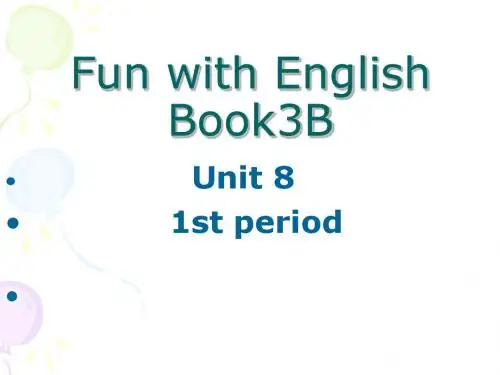
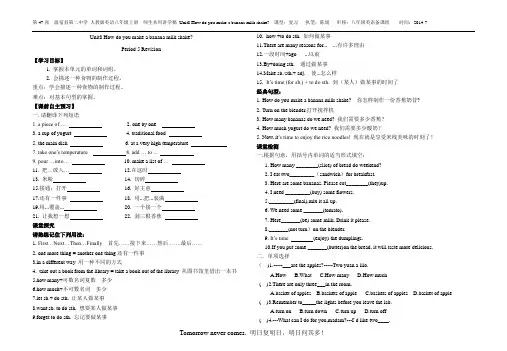
Unit8 How do you make a banana milk shake?Period 5 Revision【学习目标】1. 掌握本单元的单词和词组。
2. 会描述一种食物的制作过程。
重点:学会描述一种食物的制作过程。
难点:对基本句型的掌握。
【课前自主预习】一.请翻译下列短语1. a piece of …2. one by one3. a cup of yogurt4. traditional food5. the main dish6. at a very high temperature7. take one’s temperature 8. add … to ...9. pour …into… 10. make a list of …11. 把…放入…12.在这时13. 米粉14. 切碎15.接通;打开16. 好主意17.还有一件事18. 用...把...装满19.用...覆盖... 20. 一个接一个21. 让我想一想22. 剥三根香蕉课堂探究请熟练记住下列用法:1.First…Next…Then…Finally 首先……接下来……然后…….最后……2.one more thing = another one thing还有一件事3.in a different way 用一种不同的方式4. take out a book from the library = take a book out of the library 从图书馆里借出一本书5.how many+可数名词复数多少6.how much+不可数名词多少7.let sb.+ do sth. 让某人做某事8.want sb. to do sth. 想要某人做某事9.forget to do sth. 忘记要做某事10. how +to do sth. 如何做某事11.There are many reasons for... ...有许多理由12.一段时间+ago ...以前13.By+doing sth. 通过做某事14.Make sb./sth.+ adj. 使...怎么样15. It’s time (for sb.) + to do sth. 到(某人)做某事的时间了经典句型:1.How do you make a banana milk shake? 你怎样制作一份香蕉奶昔?2.Turn on the blender.打开搅拌机3.How many bananas do we need? 我们需要多少香蕉?4.How much yogurt do we need? 我们需要多少酸奶?5.Now, it’s time to enjoy the rice noodles! 现在就是享受米线美味的时刻了!课堂检测一.根据句意,用括号内单词的适当形式填空:1. How many ________(slice) of bread do weekend?2. I eat two_________(sandwich)for breakfast.3. Here are some bananas. Please cut________(they)up.4. I need _________(buy) some flowers.5._________(final),mix it all up.6. We need some _______(tomato).7. Here_______(be) some milk. Drink it please.8._______(not turn)on the blender.9. It’s time (enjoy) the dumplings.10.If you put some _______(butter)on the bread, it will taste more delicious.二.单项选择()1.-----___are the apples?-----Two yuan a lilo.A.HowB.WhatC.How manyD.How much( )2.There are only three___in the room.A.basket of applesB.baskets of appleC.baskets of applesD.basket of apple ( )3.Remember to_____the lights before you leave the lab.A.turn onB.turn downC.turn upD.turn off( )4.---What can I do for you,madam?---I`d like two____.A.bottle of orangeB.bottles of orangeC.bottles of oranges ( )5.There is ______milk at home.We have to buy some this afternoon.A.a littleB.littleC.a fewD.few( )6.Don`t ___the milk into the cup.It`s full.A.peelB.pourC.leaveD.drink( )7.---The banana is too big.---you can_____first.A.cut up themB.cut them upC.cut it upD.cut up it( )8.Let`s make fruit salad.---____A.No, I`m notB.Thank youC.That`s rightD.That`s a good idea ( )9.I`v no time because I`v _work to do and_books to read.A.many,manyB.many muchC.much,manyD.much,much( )10.---Would you like__?---Yes,please.A.an apple milk shakeB.a apple milk shakeC.apple milk shake课后提升根据汉语意思完成英语句子,每空一词。
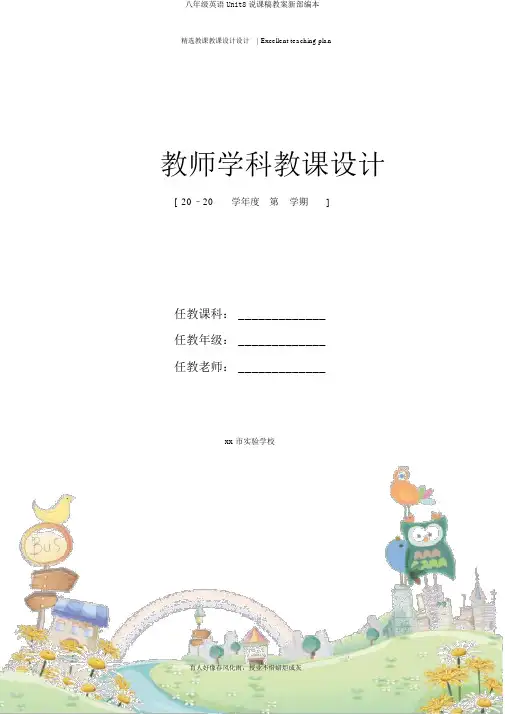
精选教课教课设计设计| Excellent teaching plan教师学科教课设计[ 20–20学年度第__学期]任教课科: _____________任教年级: _____________任教老师: _____________xx市实验学校精选教课教课设计设计| Excellent teaching plan八年级英语 Unit 8 讲课稿三中桂琪一、教材解析(一)教材的地位及作用1、元解析及教材理本是八年上册第 8 元,教材以 How was your school trip ? 中心,着描述“ 去生的事情”睁开,学和运用一般去的一般疑句 Did you go/see /buy ⋯? Were there any ⋯? 去的事件,学生学会和分享去生的事件。
本教课内容与学生的生活亲近相关,易于引学生运用的英行交和交流。
在学活中,学生通交去生的事情的描述及看法,促学生之和生之的感情交流,增情。
(二)教课目1、知目::学掌握 day off , sleep late, take a class, go fora drive 等。
功能:描述去生的事情言构:和不的一般去式一般去的一般疑句句型: I went tothe aquarium. I saw some sharps/ I went to the aquarium.、2言技术:听:能不一样句式的,并能依据化,判断句子意的化;能听懂本学活中的,做出得体的回答。
:能在本的任型活如:游、、故事接等中行有交流。
:能正确朗本元和句型;能工具完成任做准。
写:能写出本学的和句型,能运用的句精选教课教课设计设计| Excellent teaching plan子写出过去的活动和感觉。
3、学习策略:抓住用英语交际的机遇,在交际中把注意力会合在乎思的表达上,必需时借助手势和表情。
主动参加学习活动,擅长和他人合作。
4、感情目标:经过描述过去所做的事,表达自己的看法,使学生在人际交往中学会尊敬和理解他人,学会交换不一样的看法,认识他人的喜好,增进友谊。
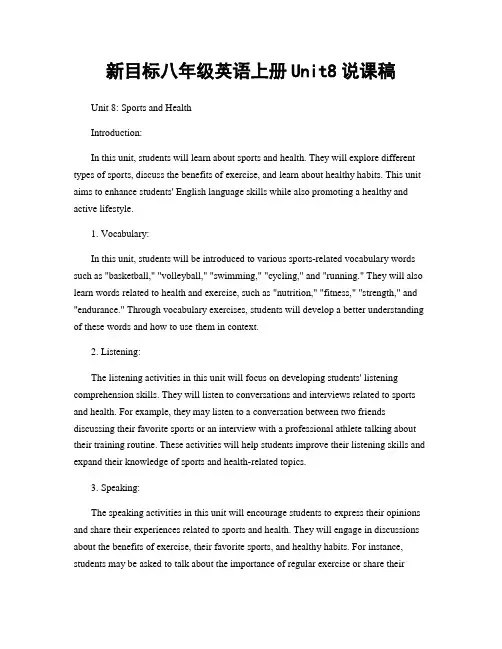
新目标八年级英语上册Unit8说课稿Unit 8: Sports and HealthIntroduction:In this unit, students will learn about sports and health. They will explore different types of sports, discuss the benefits of exercise, and learn about healthy habits. This unit aims to enhance students' English language skills while also promoting a healthy and active lifestyle.1. Vocabulary:In this unit, students will be introduced to various sports-related vocabulary words such as "basketball," "volleyball," "swimming," "cycling," and "running." They will also learn words related to health and exercise, such as "nutrition," "fitness," "strength," and "endurance." Through vocabulary exercises, students will develop a better understanding of these words and how to use them in context.2. Listening:The listening activities in this unit will focus on developing students' listening comprehension skills. They will listen to conversations and interviews related to sports and health. For example, they may listen to a conversation between two friends discussing their favorite sports or an interview with a professional athlete talking about their training routine. These activities will help students improve their listening skills and expand their knowledge of sports and health-related topics.3. Speaking:The speaking activities in this unit will encourage students to express their opinions and share their experiences related to sports and health. They will engage in discussions about the benefits of exercise, their favorite sports, and healthy habits. For instance, students may be asked to talk about the importance of regular exercise or share theirpersonal fitness goals. These activities will enhance students' oral communication skills and encourage them to express themselves confidently in English.4. Reading:The reading passages in this unit will provide students with the opportunity to improve their reading comprehension skills while learning about sports and health. They will read articles and stories about famous athletes, sports events, and the importance of a balanced diet. For example, students may read a biography of Serena Williams or an article about the benefits of eating fruits and vegetables. Through these reading activities, students will develop their reading skills and expand their knowledge of sports and health-related topics.5. Writing:The writing tasks in this unit will focus on developing students' writing skills through various exercises. They will be asked to write short paragraphs or essays about their favorite sports, the benefits of exercise, or healthy habits. For instance, students may write about why they enjoy playing basketball or the importance of staying hydrated during physical activities. These writing tasks will enhance students' ability to express their ideas in written English and improve their overall writing proficiency.6. Grammar:Throughout this unit, students will also learn and practice various grammar points related to sports and health. They will learn how to use adjectives to describe sports and physical activities, comparative and superlative forms to compare different sports, and modal verbs to express abilities and preferences. Through grammar exercises and activities, students will reinforce their understanding of these grammar concepts and improve their accuracy in using them.Conclusion:In Unit 8, students will not only enhance their English language skills but also develop a better understanding of sports and health-related topics. By engaging in variousactivities such as vocabulary exercises, listening tasks, speaking discussions, reading passages, writing tasks, and grammar exercises, students will be able to communicate confidently in English while also adopting a healthy and active lifestyle.。
Unit 8 How was your school trip?课型:新授主备:秦选科审核:谢瑾时间:06年11月班级:姓名:The First Period【学习目标】1、动词过去式的构成2、掌握句型“How was…”、“It was…”【重点难点】不规则动词过去式的构成及记忆【课前准备】1、通过预习1a、1b,请同学们试着翻译下列句子,并注意句中动词的形式went to the beach went to the aquariumhad ice cream took photosbought a souvenirs saw some sharkshung out with her friends ate some ice cream2、动词过去式的构成一般过去时中动词的过去式有规则变化和不规则变化两种。
(1)规则变化一般在词尾加-ed,具体变化如下:词尾-ed 的读音(2) 不规则动词变化量较大,须单独记忆。
常见的不规则动词有:am/is—was are—were go—went have—had do—did get—got come—came say—said see—saw put—put eat—ate take—took 【学习过程】1、看1a中的图片完成句子2、听录音,完成1b、2a3、根据1c中的对话,完成pair work4、近义词辨析:(1)else与other、another、others的区别①else为副词,修饰不定代词,疑问代词和疑问副词,作后置定语eg: Where else do you want to go ? 你还去别的什么地方?②other是形容词,修饰名词,作前置定语,常用于one…the other结构中,表示“一个……,另一个”eg: I like pandas,lions and some other animals.我喜欢熊猫、狮子和其他一些动物I have two pens.One is red,the other is green. 我有两只钢笔,一只红色的,另一只是绿色的③another用做形容词,意思是“另外的,又一的,不同的”;用做代词时,则表示“(三者以上的)另一个人或同类的东西”eg: Would you like another pear?你想再要一个梨吗?Could you show me another? 请给我看另一个好吗?④others 意思是“另外的人或物”eg: Don’t laugh at others.不要嘲笑别人(2) win与beat 的区别这两个词都有“赢得,打败”的意思,但含义不同:win表示在较强的竞争中获得胜利,它常跟的宾语有war、match、game以及表示名次、奖品等的名词,而beat后面只能接表示人的词作宾语。
听力讲义Unit 8. Toni Morrision’s Speech at Sara Lawrence College序: 01秒-----04分22秒美国黑人女小说家。
生于俄亥俄州洛雷恩。
霍华德大学毕业。
20世纪60年代末登上文坛,其作品情感炽热,简短而富有诗意,并以对美国黑人生活的敏锐观察闻名。
主要作品有《最蓝的眼睛》(1970)、《苏拉》(1974)、《所罗门之歌》(1977)和《黑婴》(1981)等。
她所主编的《黑人之书》(The Black Book),记叙了美国黑人300年历史,被称为“美国黑人史的百科全书”。
1989年起出任普林斯顿大学教授,讲授文学创作。
主要成就在于长篇小说方面。
1993年获诺贝尔文学奖。
托尼-莫里森像个魔术师一样,把不同的声音结合组织起来,构筑成不同的人物形象,而不是把自己的观点生硬地塞给读者。
她要使读者在阅读过程中真正走进小说里,同她一起品味主人公生活的甘苦,内心世界的奥妙。
莫里森的作品充满魔幻现实主义的神秘因素,她的作品还随处可见色彩和音乐的意想,语言的美感更是得到了加强。
莫里森的主要成就在于她的长篇小说。
自1970年起,她一共发表了九部长篇小说:4分22秒------20分55秒:讲解1:Toni Morrison’s Speech at Sarah Lawrence CollegeI would talk about the future. If only it were a rolled carpet / that you just had to kick / to see it unfurl limitlessly before your feet. But then there is some requirement to talk about responsibility. I am addressing, after all, bright, industrious, accomplished people / who are about to shoulder the very considerable weight of educated adulthood. So there should be some mention of responsibility. The need for and the risk in / assuming the burden of one’s own life and, in the course of that, assuming the care of another. A child, a friend, a mate, a parent, an acquaintance, even perhaps a stranger. Shouldn’t I also talk about goodness, ethical choices? I ought to.Part1重点词汇:1.if only…例If only I could fly.要是我能够飞就好了。
Unit8 How do you make a banana milk shake?Period 1 Section A 1a—2d【学习目标】1. 掌握本单元单词和词组。
2. 掌握祈使句,区分可数名词和不可数名词。
3. 学会询问和描述一种食物的制作过程。
重点:掌握祈使句,区分可数名词和不可数名词。
难点:学会询问和描述一种食物的制作过程。
【课前自主预习】一.新词自测:读写单词并熟记,看谁记得快1.奶昔2.搅拌机;果机汁3.打开4.削皮5.倒出;倾倒6.酸奶7.蜂蜜8. 增加:添加9. 西瓜10.食盐11. 最终;最后12.勺二.通过预习1a—2d,完成下列制作奶昔的过程。
How to make a banana milk shake:the bananas; the bananas; the bananas and ice-cream the blender, then the milk the blender. Next, the blender. Finally, the milk shake.课堂探究1. Turn on the blender.打开食物搅拌机。
这是一个祈使句。
祈使句用来表示请求、命令、劝告、建议等。
祈使句的主语一般都是第二人称you, 但往往省略。
祈使句的谓语用动词原形。
其否定型式是在动词原形前加Don’t。
Stop talking!Don’t always make the same mistake. 不要老犯同一个错误拓展:在一些指示牌上,通常用“No+动名词\名词”构成简略式的否定折使句。
No smoking!禁止抽烟!No parking!禁止停车!No photo!禁止拍照!短语turn on意为“打开(水,电视,收音机,灯,煤气等)”。
人称代词作为宾语应该放在turn与on之间, 即:turn it/them on. 同时须牢记的短语:turn off 关掉turn up 开大turn down 关小即学即练1 单项选择( )(1). laugh loudly in the classroom。
Unit8 How do you make a banana milk shake?一、单选。
(每小题1分,共30分) 用心、专心。
( )(1). laugh loudly in the classroom。
A. don’tB. NotC. NoD. doesn’t( )(2). I want to watch TV. Can I it ?A. turn; onB. turn; upC. turn; downD. turn; off( )(3). How meat do you want to buy?A. manyB. muchC. oftenD. long( )(4). How apples can you eat?A. manyB. muchC. longD. far( )(5) .Let him ping-pong.A. playB. playsC. to playD. playing( )6. He often ___the TV and watches the news when he returns home.A. opensB. turns onC. turns offD. turns up( )7. How much ___do you want?A. moneyB. shoesC. moneysD. apple( )8. How many ___are there in the fridge?A. waterB. cup of waterC. bottles of waterD. bottles of waters ( )9. We ___bananas before we eat them.A. eatB. hitC. peelD. cut( )10. ___milk do you want to drink?A. How manyB. How muchC. How oftenD. How long( )11.First put the bananas and yogurt in the blender, and then___.A. turn it onB. turn on itC. turn it offD. turn off it ( )12. ___of milk do you drink every day?A. How many cupB. How much cupsC. How many cupsD. How much cup ( )13.Would you like___?A. an apple milk shakeB. a apple milk shakeC. apple milk shakeD. apple milk shake( )14.You can add some sugar ___the food.A. inB. intoC. toD. on ( )15. Let’s ___milk shake.A. makeB. takeC. haveD. to make( )16. Pour the yogurt _______ the blender, please.A. onB. withC. fromD. into( )17. There is _______ bread on the plate. You can eat it for breakfast.A. fewB. manyC. a cup ofD. a piece of( )18. —_______ do you make popcorn?—First, put the corn into the popcorn machine, and then ....A. HowB. WhatC. WhereD. When( )19. —_______ there any lettuce in your sandwich? —No. I don’t likeA. IsB. AreC. WasD. Were( )20.——What is your doing now? ——_______the onions.A.Cut up B. Peel C. Cutting on D. Peeling( )21.________? ——It’s twenty yuan.A. How many is itB. What is itC. How money is itD. How much is it( )22.Please add a tomato ________the sandwich.A. onB. inC. toD. goes( )23.It’s time ____________to school.A. to goB. goC. goingD. goes( )24. Mike says he needs__________.A. to eat anythingB. to eat somethingC. eats somethingD. to eating something( )26.-----___are the apples?-----Two yuan a lilo.A.HowB.WhatC.How manyD.How much( )27.There are only three___in the room.A.basket of applesB.baskets of appleC.baskets of applesD.basket of apple ( )28.Remember to_____the lights before you leave the lab.A.turn onB.turn downC.turn upD.turn off( )29.---What can I do for you,madam?---I`d like two____.A.bottle of orangeB.bottles of orangeC.bottles of oranges ( )30.There is ______milk at home.We have to buy some this afternoon.A.a littleB.littleC.a fewD.few二、根据句意及首字母提示完成单词(每小题1分,共16分)1. Mary finishes her homework f (at last).2. She likes to eat the b (a kind of long yellow fruit) very much.3. Alice is very thirsty. She wants to d (take in sth. with mouth) something.4. How m (a lot of; lots of) mushrooms do we need?5. Please dig a big h (洞).6. Can you c (切割)it up?7. Would you like to p (倾倒) some milk into the glass?8. The worker is _________(挖) a hole over there.9. I’d like two _________(三明治) for lunch.10. How does this _________(机器) work?11. Put some more _________(黄油) in it.12. We need some _________(玉米) to make popcorn.13.You must read the I ____before you turn on the blender.14.We need two s ____of honey.15.How m ____yogurt do you want to buy?16.Don’t p ____the litter into the river.17.Look!The man is c ____an apple.18.The Spring Festival is a _________(tradition) festival in China.三、根据句意,用括号内单词的适当形式填空:(每小题2分,共30分)1. How many ________(slice) of bread do weekend?2. I eat two_________(sandwich)for breakfast.3. Here are some bananas. Please cut________(they)up.4. I need _________(buy) some flowers.5._________(final),mix it all up.6. We need some _______(tomato).7. Here_______(be) some milk. Drink it please.8._______(not turn)on the blender. 9. It’s time (enjoy) the dumplings.10.If you put some _______(butter)on the bread, it will taste more delicious.11. I want two ______ (sandwich).12. Do you like eating ______ (tomato)?13. It is time ______ (give) thanks for food in the autumn.14. They are ready ______ (start) on Friday.15. We celebrate his birthday party by _____ (sing) and ______ (dance) together.四、根据汉语意思完成句子(每小题2分,共24分)1.你喜欢带有莴苣的三明治吗?Do you like sandwiches ______ ______ ?2.在特殊的节日,人们通常吃传统的食物。
On _____ days, people usually eat ______ food.3.通过读这篇文章我学到了许多。
I learned a lot _____ ______ the article.4.我用蜂蜜填满了这个罐子。